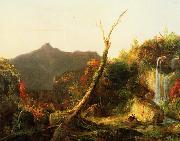
Oil On
Canvas, Real Flavor of Old Masters
|
Thomas Cole
|
|||
|
|
|||
| 1801-1848 Thomas Cole Galleries Thomas Cole (February 1, 1801 - February 11, 1848) was a 19th century American artist. He is regarded as the founder of the Hudson River School, an American art movement that flourished in the mid-19th century. Cole's Hudson River School, as well as his own work, was known for its realistic and detailed portrayal of American landscape and wilderness, which feature themes of romanticism and naturalism. In New York he sold three paintings to George W. Bruen, who financed a summer trip to the Hudson Valley where he visited the Catskill Mountain House and painted the ruins of Fort Putnam. Returning to New York he displayed three landscapes in the window of a bookstore; according to the New York Evening Post, this garnered Cole the attention of John Trumbull, Asher B. Durand, and William Dunlap. Among the paintings was a landscape called "View of Fort Ticonderoga from Gelyna". Trumbull was especially impressed with the work of the young artist and sought him out, bought one of his paintings, and put him into contact with a number of his wealthy friends including Robert Gilmor of Baltimore and Daniel Wadsworth of Hartford, who became important patrons of the artist. Cole was primarily a painter of landscapes, but he also painted allegorical works. The most famous of these are the five-part series, The Course of Empire, now in the collection of the New York Historical Society and the four-part The Voyage of Life. There are two versions of the latter, one at the National Gallery in Washington, D.C., the other at the Munson-Williams-Proctor Arts Institute in Utica, New York. Cole influenced his artistic peers, especially Asher B. Durand and Frederic Edwin Church, who studied with Cole from 1844 to 1846. Cole spent the years 1829 to 1832 and 1841-1842 abroad, mainly in England and Italy; in Florence he lived with the sculptor Horatio Greenough. | |||
|
|
|||
|
|
Autumn Landscape Rogier van der Weyden28.jpg Painting ID:: 9896 Visit European Gallery |
1827Oil on canvas | |
Height Width |
INS/CM |
||
|
X |
|
||
|
|
|||
|
Jervis Mcentee
|
|||
|
|
|||
| American Realist Painter, 1828-1891, He was an American painter of the Hudson River School. He is a somewhat lesser-known figure of the 19th century American art world, but was the close friend and traveling companion of several of the important Hudson River School artists. Aside from his paintings, McEntee's enduring legacy are the detailed journals he kept from the early 1870s until his death. In his writings McEntee records a detailed account of Hudson River School artists, their day-to-day life, gossip and personal reflections, and the overall arc of the American art world in the second half of the 19th century. He discusses his artistic successes and trials, particularly as money becomes more scarce with the decline in popularity of Hudson River School art. McEntee's journals are now kept by the Archives of American Art, a research center within the Smithsonian Institution. Five volumes of these diaries, from 1872 to 1890, have been digitally scanned, transcribed, and can be browsed in their entirety in the Jervis McEntee Diaries Online. McEntee was born in Rondout, New York on July 14, 1828. Little is known of his childhood. He exhibited his first painting at the National Academy of Design in New York City in 1850. | |||
|
|
|||
|
|
Autumn Landscape new11/Jervis Mcentee-339785.jpg Painting ID:: 37642 Visit European Gallery |
mk127 22x28 | |
Height Width |
INS/CM |
||
|
X |
|
||
|
|
|||
|
Levitan, Isaak
|
|||
|
|
|||
| Russian Painter, 1860-1900 Russian painter of Lithuanian birth. He largely painted landscapes (including pastel sketches), which are noted for their emotive or symbolic resonance. His 'landscapes of mood' had a profound influence on Russian landscape painting, to which he introduced a sense of the unity of humankind and nature, and of the spiritual power of the Russian | |||
|
|
|||
|
|
Autumn Landscape new12/Levitan, Isaak-868845.jpg Painting ID:: 39229 Visit European Gallery |
mk144 Pastel on carton 30x51xm | |
Height Width |
INS/CM |
||
|
X |
|
||
|
|
|||
|
Julien Dupre
|
|||
|
|
|||
| 1851-1910 French Julien Dupre Location | |||
|
|
|||
|
|
Autumn Landscape new16/Julien Dupre-223489.jpg Painting ID:: 41082 Visit European Gallery |
mk159 Oil on canvas 51x46cm | |
Height Width |
INS/CM |
||
|
X |
|
||
|
|
|||










